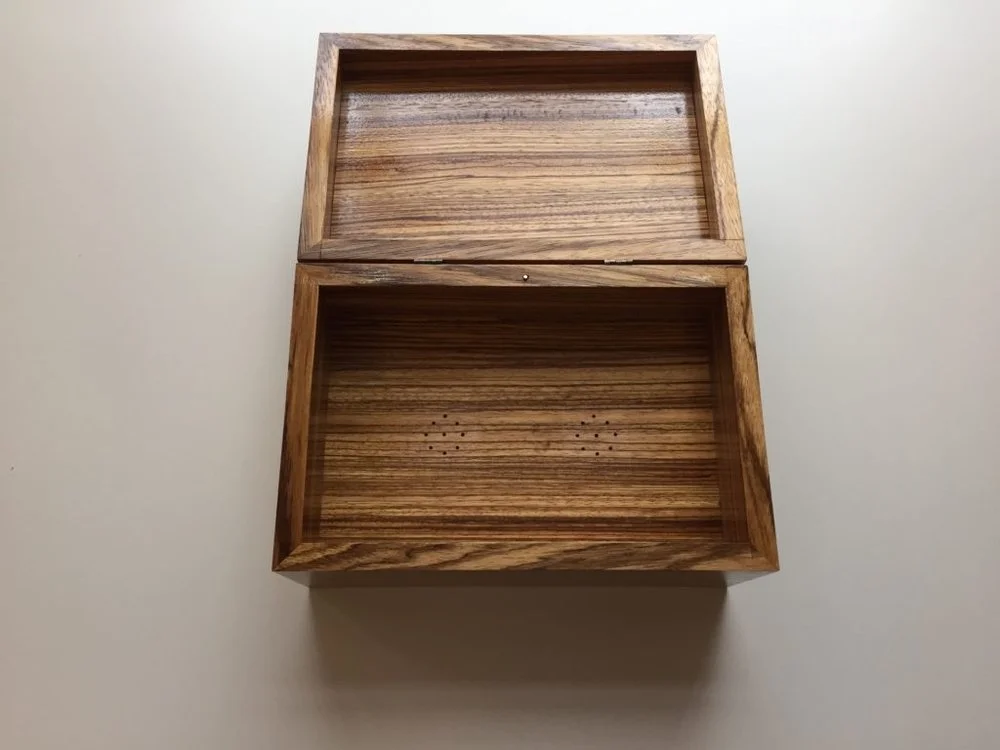Patience, Young Woodworker. How to Balance Drive and Moderation.
Measure Forty Times. Cut Once.
Throughout our lives, we are stretching, reaching and moving towards what we envision a “perfect” life looks like. This may mean promotions, buying that luxury car, or hitting your high school weight.
Then you finally hit that goal, celebrate your success....and then...
What’s next?
There’s always something more to reach for. Someone with a job that you envy, a better car or a more skilled craftsman. So you reset your goals and push for even more. It’s a cycle that we see all the time in both material goods and emotional needs.
Of course, striving to improve and grow is important- it pushes us to work harder and try new things. It helps us learn to fail and recover, to step out of our comfort zones and have an end goal in mind. These are all incredibly helpful traits- but we forget the gumption, gains and knowledge procured in the journey.
Motivated and driven people (I'm raising my hand) tend to focus on the end.
Just running some errands.
We miss incredible lessons if we could sometimes let the natural order of things dictate the pace. I am guilty of pushing through work and tasks - my family even gave me the nickname of “Action Vranas”.
To me, that nickname is a complement. I’m prone to getting things done with the highest of quality while using my experiences and knowledge to move from Point A to Point B with speed and efficiency. It wasn’t until I tried my hand at a new hobby that I gained an appreciation of patience.
I’ve always been handy. It started in high school when I volunteered with Habitat for Humanity. The time I hammered nails into wood and could step back and see a functional part of a house...it was a magical feeling. I’ve worked with Habitat across the country and that feeling of accomplishment remains.
As I've moved into different homes I’ve toyed around with making little objects and have a satisfaction of being able to fix some things around the house. I never had the right tools or knowledge, but I could slop together something that looked generally passable. Happy wife, happy life...right?
Actor, woodworker, meat lover.
Around the same time I started to crave some real knowledge of woodworking, I came across a book by Nick Offerman, of Parks and Recreation fame. Nick plays Ron Swanson, a red meat-eating, sarcastic, overly masculine character with deadpan humor and an incredible moustache. I imagined his writing could be fun, so I dug in. Little did I know this book would lead me on a new journey and perspective on life.
Nick, aside from being a talented comedian and proud Chicagoan, is a master woodworker. After reading his book and hearing the love he had for the art of woodworking, I decided it was time to either put up or shut up. Either dig in and learn, or continue to be mediocre.
I found the Chicago Industrial Arts & Design Center - a nonprofit that teaches schmos like me woodworking, metallurgy and casting. Walking in the first time was like a portal into a new world. I showed off my amateur skills and was allowed into the Intermediate Woodworking course- ten, 4 hour sessions. As my luck would have it, I was the only one signed up so I was one-on-one with a master woodworker, Erik.
I had a few projects I wanted to get done and with this new individual attention, I figured we’d be covered in sawdust in no time and I’d be creating tons of cool items.
Much to my chagrin, the first session we didn’t cut a single piece of wood.
Instead, Erik spent those first four hours walking me around the shop, introducing me to each tool. How to take them apart, put them together, make sure they are working properly. Measuring the angle of a table saw to show if it is off by one-sixteenth of an inch, an error that reverberates up through the rest of the project (I always thought that’s what wood filler was for). Listening to the sound of a machine that isn’t clean and how that would ruin the end of a cut. Understanding the differences between different types of sealers depending on the wood type. To say the least, I was frustrated but had no choice but to trust the process.
I figured next session, we’d start chopping away at some real work.
Dead wrong.
The second session, we spent planning out my first project. For four hours. What was this super complex item? A small box. Action Vranas was getting more than a little impatient, but had to trust Erik and his experience. We sketched out and discussed every angle, joint, and measurement. We considered the weight of a box using standard depth wood and realized we could make it lighter by planing the wood (slowly- VERY slowly- shaving down the depth). I upped the ante by wanting to create a digital music box with an MP3 player and speaker, so we had to think about the vibration of the speakers, how to best mount it and the effects of sound waves on the wood.
Needless to say, 20% of my class was done and I hadn’t touched a piece of wood.
Erik sent me to a local lumberyard to get some quality wood. I thought it would be like walking into Home Depot, but as I stepped into Owl Lumber I was overcome with awe. The smell of fresh lumber, walking among real carpenters and seeing hundreds of varieties of wood, I started to feel like an overwhelmed kid in a candy store. After walking around for a while and realizing I had no idea what I was doing, I sucked it up and asked for help.
My new guide helped me settle on an exotic Zebrawood. He warned it was a difficult wood to work with and smelled terrible when you cut it, but if you treated her right the finished product would be spectacular. There were more tips and tricks handed down from other guys around, but my mind was swimming. The advice I kept hearing was...take your time. Be patient. Don’t rush wood.
Back to the workshop, I was ready to make the box. Here we go.....right? On day 3 we made a spectacular *8* cuts to make the sides of the box. In 4 hours. In fairness, we also shaved the wood down to half of the original depth. 12 hours of work so far and this was it? At the end of that day, I was getting a little impatient, until Erik suggested we see how the box fit together.
It was magical.
The 4 sides came together in a perfect fit. When I say perfect, I mean perfect. The grain of the wood continued around each corner. The joints and corner were snug and everything was perfectly leveled. We glued it together. No nails. No sanding or wood filler to cover up my errors. I finally understood what all the time “wasted” was for.
The next three weeks we slowly continued to progress. I saw the care that was taken into what seemed like complicated steps. Steps that nobody would ever know or appreciate. I started to understand the ethos of a master craftsman. They know that these steps, this time and labor matter. Not to the end user, but to them. If they cut those corners, they would always look at the finished product with a sense of discontent, even if nobody else did.
After a total of six weeks, the box was finally finished.
I then set off to create the electronics. This included learning how to solder, a new knowledge of battery power and circuitry. I luckily found a friend of a friend that started me on the right path and some resources on the good old internet. While trying to meld together an MP3 player, battery, speakers and switch (so the music only turned on when the box was open) brought up some frustrations, I was approaching this project in a new way.
I found a new sense of patience with myself, the inanimate tools that I used to yell when things didn’t go well and the process of creating. I knew there were shortcuts that I could take, but stopped myself. Action Vranas was turning into Craftsman Vranas.
Finally, I assembled the music box.
It took $80 worth of wood, $40 worth of electronics....and upwards of 100 hours of combined labor. When I attached the last hinge, I took a step back - it was perfect. There wasn’t a nagging feeling that something could have been done differently. There was a new sensation I felt that day- a mixture of calm confidence and internal satisfaction that is hard to describe.
And a strange bond with this inanimate object - I knew that box inside and out, the cuts and work nobody would notice and the journey we went on together from a piece of wood to an heirloom.
Since then, I’ve used all those lessons to create larger, more substantial pieces of furniture. Yet, I find that the journey I took with that first, small project is always with me. Reminding me to slow down and listen to the wood. Pay attention to every little detail. Do it right the first time and you won't have to try to cover up mistakes. Be proud of the journey as much as the finished project.
The added and unintended consequence of starting to learn these skills and ethos is that they have moved over into my professional work. I still pride myself on and unforgiving pace, quality and efficiency, I now bring a new attitude to getting work done.
Slowing down and enjoying the steps along the way as much as the finished project. Paying more attention to what the work is telling me and not trying to bend something (or someone) in ways that nature didn’t intend. Use the right tools for the job, and care immensely about every part of the work even if nobody else will notice.
We are surrounded by cheaply made objects that are meant to be thrown away. We have become slaves to pushing decent quality work out the door. We are always looking to get to that next goal, next promotion, upgrade our stuff that we’ve lost sight of enjoying the moment we are in, the people around us and the road we are on.
So slow down, smell the cut lumber and enjoy the journey.
This was written while listening to the vinyl album:
Ryan Adams
Gold (2002)





